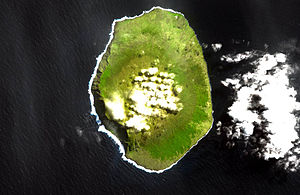|
Falaises d'Entrecasteaux  The Falaises d'Entrecasteaux (French pronunciation: [falɛz dɑ̃tʁəkasto]; in English the Cliffs of Entrecasteaux, named after 18th century French navigator Bruni d'Entrecasteaux) comprise the cliffs, which reach heights of over 700 m, along the west coast of Amsterdam Island, a small French territory in the southern Indian Ocean. Important Bird AreaThe western coastline of the island, including the cliffs, has been identified as a 360 ha Important Bird Area (IBA) by BirdLife International because it is home to one of the largest colonies of Indian yellow-nosed albatrosses in the world, with about 19,000 pairs constituting some 20% of the world population, and about 240 pairs of sooty albatrosses. There is also a large colony of northern rockhopper penguins, with 25,000 pairs. Two species, grey and soft-plumaged petrels, which have become rare on the island due to predation by rats and cats, are thought to breed in the IBA. There is a large rookery of subantarctic fur seals in the IBA. Ten endemic arthropods have been recorded.[1] The vegetation, which includes three endemic plant species, is dominated by tussock-grasses and rushes which are densest towards the foot of the cliffs. Because of the inaccessibility of the cliffs, the vegetation of the cliff-ledges was never grazed by the feral cattle that used to inhabit the island.[1] References
|